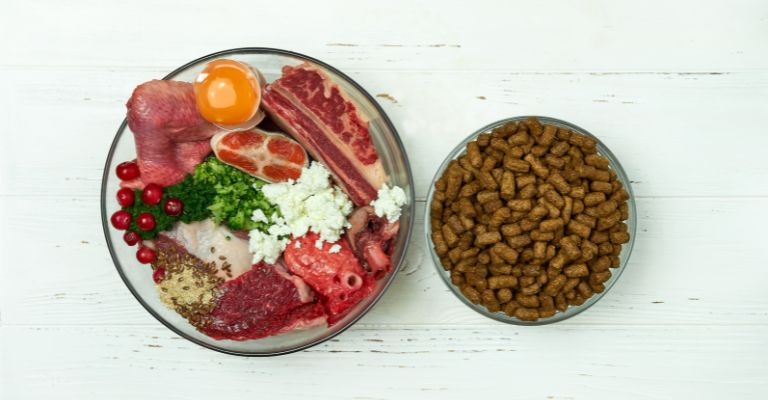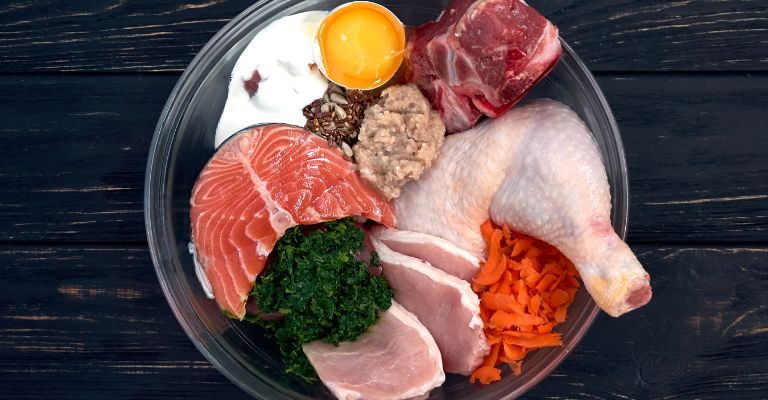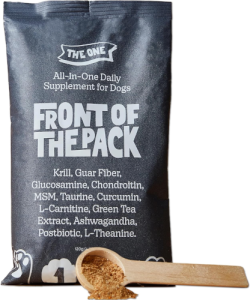So you’ve been considering switching your dog’s diet to raw and wondering where to start? Look no further! This beginner’s guide will walk you through the step-by-step process of transitioning your furry friend to a raw food diet. From understanding the benefits of a raw diet to gradually introducing new ingredients, we’ve got you covered. Get ready to embark on a nutritional journey that will enhance your pup’s overall well-being and help them thrive. Let’s get started!

Benefits of a Raw Diet for Dogs
Improved Digestion
Switching to a raw diet can greatly improve your dog’s digestion. Raw food is easier for dogs to digest compared to processed kibble. When dogs consume raw food, their bodies are able to break it down more efficiently, leading to better nutrient absorption and less strain on the digestive system. This can help alleviate common digestive issues like bloating, gas, and loose stools. By ensuring that your dog’s digestive system is functioning optimally, you are promoting their overall well-being and comfort.
Healthier Skin and Coat
One of the most noticeable benefits of feeding your dog a raw diet is the improvement in their skin and coat health. Raw food is rich in essential fatty acids, such as Omega-3 and Omega-6, which are crucial for maintaining healthy skin and a shiny coat. These fatty acids help reduce inflammation, prevent dryness and itching, and promote a lustrous, soft coat. Additionally, the high moisture content in raw food helps keep your dog hydrated, further contributing to their skin and coat health.
Increased Energy
If you’ve noticed that your dog seems sluggish or lacks energy, switching to a raw diet may be the solution. Raw food provides dogs with a natural source of energy, as it contains all the essential nutrients they need to thrive. The absence of fillers, artificial additives, and excessive carbohydrates commonly found in commercial dog food can lead to spikes in energy levels and improved overall vitality. With increased energy, your dog will be more active, playful, and likely to enjoy a better quality of life.
Stronger Immune System
Feeding your dog a raw diet can boost their immune system, helping them fight off infections and diseases more effectively. Raw food is packed with essential vitamins, minerals, and antioxidants that support immune function. The natural enzymes present in raw food also aid digestion and absorption of these nutrients, allowing your dog’s immune system to function optimally. A strong immune system can help prevent illnesses, promote faster healing, and improve their overall resistance to common ailments.
Consulting with a Veterinarian
Importance of Professional Advice
Before starting your dog on a raw diet, it is crucial to consult with a veterinarian who specializes in canine nutrition. They have the expertise and knowledge to guide you through the process and ensure that your dog’s specific needs are being addressed. A veterinarian can help assess your dog’s overall health, identify any underlying conditions or allergies, and provide tailored advice on transitioning to a raw diet. Their professional guidance is essential to make informed decisions and create a balanced raw food plan.
Choosing a Raw Food Diet
During your consultation with a veterinarian, they will help you choose the most suitable raw food diet for your dog. There are various approaches to raw feeding, including the Prey Model and BARF (Biologically Appropriate Raw Food) diet. The veterinarian will consider your dog’s breed, age, size, activity level, and any existing health conditions when recommending the best diet plan. They will also discuss the potential risks and benefits associated with raw feeding, enabling you to make an educated decision that prioritizes your dog’s well-being.

Transitioning to a Raw Diet
Gradual Switching Process
Transitioning your dog to a raw diet should be done gradually to minimize any digestive discomfort. Start by replacing a small portion of their current food with raw food and gradually increase the ratio over a period of 7-10 days. This slow transition allows your dog’s digestive system to adapt to the new diet and reduces the likelihood of gastrointestinal upset. Monitor your dog closely during this transition period for any signs of digestive issues and adjust the pace accordingly.
Calculating the Right Portions
Feeding your dog the appropriate portion sizes is crucial to maintain their overall health and weight. Consult with your veterinarian or a qualified canine nutritionist to determine the correct portion sizes based on your dog’s weight, age, and activity level. They will help you create a tailored feeding plan that ensures your dog receives all the necessary nutrients without overfeeding or underfeeding. Regularly assess your dog’s body condition and adjust the portion sizes as needed to maintain a healthy weight.
Monitoring Your Dog’s Transition
Keep a close eye on your dog’s overall well-being during the transition phase. Monitor their energy levels, appetite, and bowel movements to ensure they are adjusting well to the raw diet. If you notice any concerning changes or if your dog experiences persistent digestive issues, consult with your veterinarian promptly. They can provide further guidance and help troubleshoot any issues that may arise during the transition process.
Types of Raw Food for Dogs
Raw Meat and Bones
Raw meat and bones form the foundation of a raw diet for dogs. Dogs are natural carnivores and require a source of high-quality, raw protein to thrive. Chicken, beef, lamb, and fish are commonly used in raw feeding. These protein sources provide essential amino acids, vitamins, and minerals necessary for your dog’s overall health. Incorporating raw meaty bones, such as chicken wings or beef ribs, helps promote dental health and provides mental stimulation for your dog while they chew.
Organ Meats
Organ meats are a vital component of a balanced raw diet for dogs. They are incredibly nutrient-dense and provide essential vitamins and minerals such as iron, copper, and vitamin A. Liver, kidneys, heart, and spleen are examples of organ meats that are commonly included in raw feeding. It is important to source high-quality organ meats from reputable suppliers to ensure their freshness and avoid potential contamination.
Fruits and Vegetables
While dogs are primarily carnivorous, many raw feeding advocates believe that incorporating small amounts of fruits and vegetables can contribute to a well-rounded diet. Fruits and vegetables provide additional vitamins, minerals, and antioxidants that can support your dog’s overall health. Some commonly used options include carrots, spinach, blueberries, and pumpkin. It is essential to properly prepare fruits and vegetables for your dog by either pureeing, lightly steaming, or finely chopping them to enhance digestibility.
Supplements
To ensure a well-balanced raw diet, some dog owners choose to add supplements to their dog’s meals. These supplements can help address any nutritional gaps that may arise due to specific dietary restrictions or individual needs. Common supplements include fish oil for Omega-3 fatty acids, probiotics for gut health, and joint supplements for aging dogs. Before incorporating any supplements into your dog’s diet, consult with your veterinarian to ensure they are necessary and the appropriate dosages are provided.

Preparing Raw Meals for Your Dog
Proper Storage and Handling of Raw Food
When preparing raw meals for your dog, it is crucial to follow proper storage and handling practices to prevent bacterial contamination and ensure food safety. Store raw food in airtight containers in the refrigerator or freezer to maintain freshness and prevent spoilage. Thaw frozen raw food portions in the refrigerator and avoid leaving them at room temperature for extended periods. Clean all utensils, cutting boards, and surfaces thoroughly after handling raw meat to minimize the risk of cross-contamination.
Balancing Nutritional Needs
Achieving a well-balanced raw diet for your dog requires careful consideration of their nutritional needs. Work closely with your veterinarian or a qualified canine nutritionist to determine the appropriate ratios of proteins, organs, bones, fruits, and vegetables. They can help you create a feeding plan that meets your dog’s specific requirements, ensuring they receive the necessary nutrients in the correct proportions. Regularly rotate protein sources and vary the types of fruits and vegetables to provide a diverse range of nutrients.
Meal Preparation Tips and Techniques
Meal preparation for a raw diet can be quite simple and straightforward. Cut raw meat into appropriate portions suitable for your dog’s size and age. Add organ meats and finely chopped or pureed fruits and vegetables as per your dog’s dietary plan. Include raw meaty bones for dental health benefits and chewing pleasure. Some dog owners choose to batch prepare meals for convenience by portioning and freezing individual servings. This allows for easy mealtime preparation and ensures the freshness of the food.
Common Concerns and Risks
Bacterial Contamination
One of the main concerns associated with raw feeding is the risk of bacterial contamination. Raw meat can contain harmful bacteria such as Salmonella or E. coli, which pose health risks to both dogs and humans. It is important to handle raw food safely, follow proper hygiene practices, and source raw ingredients from reputable suppliers. Minimizing potential contamination and regularly monitoring your dog for any signs of illness can help mitigate this risk.
Nutritional Imbalances
Another concern is the potential for nutritional imbalances when feeding a raw diet. It is essential to provide a balanced raw diet that addresses your dog’s nutritional requirements. This includes offering a variety of protein sources, organ meats, fruits, and vegetables. Working with a veterinarian or a qualified canine nutritionist can help ensure that your dog’s diet is properly balanced, and any nutritional gaps are identified and addressed through appropriate supplementation.
Allergic Reactions
While a raw diet can benefit many dogs, some may develop allergic reactions or sensitivities to certain ingredients. It is crucial to closely monitor your dog’s response to the new diet and seek veterinary guidance if any adverse reactions occur. Identifying any food allergies or intolerances early on enables you to adjust their diet accordingly and provide alternative ingredients that are better tolerated.
Addressing Health Issues with Raw Diets
Weight Management
If your dog is struggling with weight management issues, a raw diet can be an effective solution. Raw food tends to be more nutrient-dense and less calorie-dense compared to commercial dog food. This allows for portion control while still meeting your dog’s nutritional needs. Work with your veterinarian to determine the appropriate caloric intake and adjust the portion sizes accordingly to achieve and maintain a healthy weight for your dog.
Food Allergies
Food allergies are a common concern for many dog owners. Raw diets can be an excellent option for dogs with food allergies, as they allow for precise control over ingredients. By eliminating potential allergens commonly found in commercial dog food, you can identify and exclude the specific ingredients causing allergic reactions. Consult with your veterinarian to create a raw food plan that avoids the allergens while still ensuring a nutritionally balanced diet.
Dental Health
Maintaining good dental health is essential for your dog’s overall well-being. Chewing on raw meaty bones helps scrape away plaque and tartar buildup, promoting healthy teeth and gums. The natural chewing action exercised while consuming raw bones also provides mental stimulation and satisfies your dog’s natural urge to chew. Regular veterinary dental check-ups and dental hygiene practices should still be part of your dog’s overall dental care routine.
Transitioning Puppies to a Raw Diet
Puppy Nutritional Requirements
Puppies have specific nutritional requirements to support their rapid growth and development. When transitioning a puppy to a raw diet, it is crucial to ensure they receive adequate nutrients for optimal health. Puppies require higher amounts of protein, calcium, and other essential nutrients compared to adult dogs. Work closely with your veterinarian to create a custom raw feeding plan that meets the specific needs of your growing puppy.
Modified Transition Process
Transitioning a puppy to a raw diet follows a similar process as transitioning an adult dog, but with some modifications. Puppies have more sensitive stomachs and may require a longer transition period. Start by including small amounts of raw food alongside their current puppy food and gradually increase the ratio over two to three weeks. Monitor your puppy closely for any signs of digestive upset and adjust the transition pace accordingly. Regular veterinary check-ups are crucial during this growth stage to ensure your puppy is thriving on the raw diet.
Raw Diet Myths and Misconceptions
Raw Diets Are Not Balanced
One common misconception about raw diets is that they are inherently unbalanced and lack essential nutrients. While it is true that feeding an unbalanced raw diet can pose health risks, a properly formulated raw diet can provide all the necessary nutrients for a dog’s optimal health. By working with a veterinarian or a qualified canine nutritionist, you can create a meticulously balanced raw diet that addresses your dog’s unique nutritional needs and mitigates any potential deficiencies.
Cooking Eliminates All Nutrients
Some dog owners believe that cooking raw food is necessary to eliminate potential pathogens and ensure the safety of their dog’s diet. While cooking does kill bacteria, it also significantly reduces the nutritional value of the food. Essential enzymes, vitamins, and amino acids are destroyed in the cooking process, as they are heat-sensitive. Raw feeding advocates emphasize that handling and sourcing raw food safely, along with proper hygiene practices, can minimize the risk of bacterial contamination without compromising the nutritional benefits.
Resources for Switching to a Raw Diet
Books and Literature
There are numerous books and literature available that provide valuable insights and guidance on switching to a raw diet for dogs. Some recommended titles include “Unlocking the Canine Ancestral Diet” by Steve Brown, “Raw and Natural Nutrition for Dogs” by Lew Olson, and “Give Your Dog a Bone: The Practical Commonsense Way to Feed Dogs for a Long Healthy Life” by Ian Billinghurst. These resources offer valuable information, feeding guidelines, and recipe ideas to help you navigate the transition successfully.
Online Communities and Forums
Engaging with online communities and forums dedicated to raw feeding can provide a wealth of knowledge and support. Connecting with experienced raw feeders and exchanging ideas, tips, and recipes can be invaluable when starting your dog on a raw diet. Some popular online communities include raw feeding Facebook groups, dedicated forums, and raw feeding blogs. It is important to remember that while these communities can be helpful, always consult with your veterinarian for professional advice tailored to your dog’s specific needs.
Local Raw Food Suppliers
Finding reputable local raw food suppliers can simplify the process of switching to a raw diet. These suppliers often offer a range of commercial raw food options, including premade raw meals or whole ingredients for DIY raw feeding. Research and choose suppliers that prioritize quality, sourcing from trusted farms or sources. Local pet stores specializing in raw feeding or independent butchers may be able to provide guidance on selecting the best raw food options for your dog.
By following these comprehensive guidelines, consulting with a veterinarian, and using the available resources, you can successfully switch your dog to a raw diet. Remember to closely monitor your dog’s well-being throughout the transition process and make adjustments as necessary. A raw diet can provide numerous benefits for your dog’s overall health and well-being, ensuring they live a happy, vibrant life.


